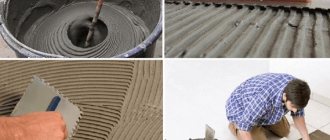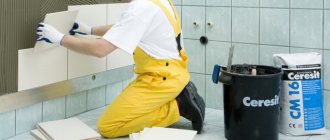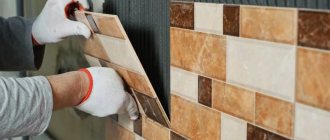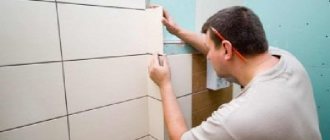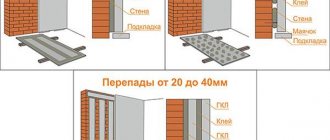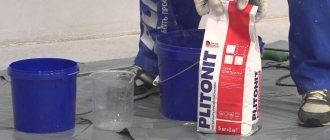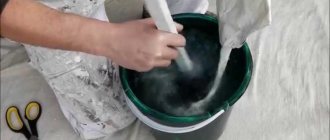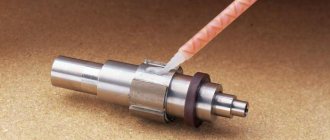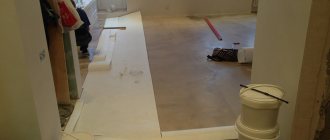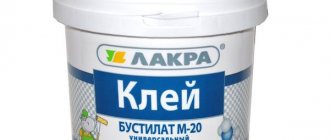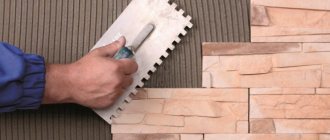One of the well-known names among tile adhesives is KREPS. Bright packaging attracts the eyes of buyers. It is necessary to understand which mixture among the variety presented, first of all, to pay attention to. KREPS “Reinforced” adhesive for tiles and porcelain stoneware has certain features that are worth talking about in more detail.
Brand information
The KREPS company began its activities in the late nineties, more than 20 years ago. Since that time, it has launched the production of dry mixtures used in construction. Today the company has the status of a federal manufacturer. There are two large factories in the Russian Federation, located in the Urals and St. Petersburg.
Among the products of this company, more than 50 types of goods can be distinguished. This list includes KREPS adhesive for tiles, main types of plaster, putties, dry mixtures with the main component of cement, special leveling solutions for damaged floor coverings and much more.
All products undergo strict testing before going on sale. Thanks to this, the risk for consumers of purchasing low-quality building materials is reduced to almost zero.
Features and advantages of the KREPS brand
To find out what strengths dry adhesives from the KREPS company have, you need to consider their compositions.
Standard components are:
- Cement.
- Various modifiers.
- Sand.
- Additives for plasticization.
Before you start working, you need to prepare the adhesive mass. To do this, the dry powder is diluted with water according to the proportions indicated on the packaging.
If the solution is mixed correctly, it will have the specified technical characteristics of tile adhesive:
- Brand strength – M 75.
- Adhesive strength – 1 MPa.
- Frost resistance index – F 35.
KREPS tile adhesive under the “Reinforced” brand has parameters that are higher than those of dry mixes under the name “Standard”. In addition, after mixing the composition, you can work with it for 20 minutes longer. The reinforced composition tolerates temperature changes, thanks to this, you can work with it outdoors or at home when installing a “warm floor” system.
In addition to the improved characteristics presented above, KREPS “Strengthened” adhesive has other advantages.
These include:
- High frost resistance.
- Long-term moisture resistance.
- Economical due to low consumption.
- Sets quickly.
A separate group of adhesives is modified with additional additives to improve the basic characteristics. These can be fireproof substances, antifreeze.
Mixing and storing Kreps glue
To prepare the glue, you need to take 6 liters of liquid per 25 kg of Kreps glue. Mixing is carried out using hand tools or a mixer at low speed. The mixture should stand for 10 minutes, after which it is mixed again. The viability of the finished composition is maintained for 4 hours.
The product can be stored in its original packaging for 12 months in a dry place on a stand.
In the video: Mixing the adhesive mixture and laying floor tiles using KREPS REINFORCED tile adhesive.
Application area
KREPS “Reinforced” adhesive has improved technical characteristics. Thanks to this, the scope of its application is expanding. The mixtures can be used when finishing rooms with ceramic tiles and large porcelain stoneware slabs. This glue is suitable for working with natural or artificial stone.
KREPS adhesive composition is used for laying decorative coatings on various substrates:
- Concrete screeds (“warm floor”).
- Drywall, gypsum boards.
- Any types of plaster.
High levels of frost resistance and moisture resistance allow finishing of the external sides of buildings.
Types of KREPS adhesive for tiles
Tile adhesive of the KREPS line from one of the leading companies has many names. The corporation sells several items that have varied characteristics. We need to talk about them in more detail.
KREPS “Reinforced” 25 kg
KREPS “Reinforced” tile adhesive 25 kg, which can be found in any specialized store. Recommended for finishing work with ceramic tiles, porcelain stoneware slabs, and other decorative materials.
This tile adhesive is well suited for working both on the inside of walls and on the outside (outside of buildings). Designed for laying slabs on almost all vertical and horizontal prepared surfaces.
List of such places:
- Gypsum boards.
- Any types of plaster.
- Cellular concrete.
- Screeds (“warm floor”).
- Fireplace cladding.
- Drywall.
Specifications:
- The time until the solution hardens is 4 hours.
- The time period for adjusting the position of the tiles is 20 minutes.
- Temperatures for using the finished composition are from 0 to +25 degrees.
- Average consumption of KREPS “Reinforced” glue per 1 m2 ~ packaging per 8 m2.
Grouting work is carried out no less than 24 hours later. After grouting, the surface will be ready for use.
Features of enhanced solutions
Kreps Reinforced glue is produced in bags of 5 and 25 kg, and is a dry cement-based building composition. It also contains sand, modifiers, plasticizers, while the total fraction size does not exceed 0.63 mm.
The main difference between the “Enhanced” products and the “Standard” category is that the technical characteristics of the former have been seriously improved. In particular, with proper dilution, the adhesion of the solution will be at least 1 MPa, whereas for standard products it rarely exceeds 0.3-0.8. Also, this tile adhesive has high frost resistance - up to 35 cycles of freezing, defrosting and more.
Other differences between products in the “Enhanced” category:
- extending the time for work in general and for adjusting tiles,
- minimal slipping even when laying large elements (up to 0.5 mm),
- withstands a wide temperature range,
- the ability to be used for external and internal work, including when installing heated floors, building facades, plinths, parapets, stairs.
Some manufacturers add Kreps antifreeze to the glue. This helps tiling the outside of buildings even at sub-zero temperatures (usually down to -10 degrees).
KREPS glue “White reinforced” 25 kg
KREPS products with improved characteristics. Its key feature is white color. Due to this, it is used for laying glass tiles. Used for finishing work with ceramic and porcelain tiles. Due to its increased resistance to high and low temperatures, it is possible to use adhesive for screeds with installed “warm floors”.
Used for laying slabs on different surfaces. List of such places:
- Gypsum boards.
- Any plasters.
- Cellular concrete.
- Warm floor screeds.
- Drywall.
Specifications:
- The average consumption of the finished mixture is 2 kg per 1 sq.m.
- The time until the solution hardens is 4 hours.
- The time period for adjusting the position of the tiles is 15 minutes.
- Temperatures for using the finished composition are from 0 to +25 degrees.
Grouting work should be carried out after 2 days.
The solution is suitable for lining the internal walls of swimming pools, fireplaces, and external walls of buildings.
KREPS glue “Reinforced winter” 25 kg
To perform facing work, use tile adhesive “Winter” KREPS. Intended for laying ceramic tiles and porcelain stoneware slabs. The main value of the adhesive composition is the stability of the installation quality at low temperatures, as well as to the effects of dampness and moisture. Thanks to this, it is better suited than others for finishing buildings outside.
Used for laying slabs on a variety of surfaces. Which include:
- Gypsum boards.
- Different types of plaster.
- Cellular concrete.
- Warm floor screeds.
- Drywall.
Specifications:
- The average consumption of the finished mixture is 2 kg per 1 sq.m.
- The time until the solution hardens is 4 hours.
- The time period for adjusting the position of the tiles is 15 minutes.
- Temperatures for using ready-made glue are from -10 to +25 degrees.
After 24 hours it is necessary to grout the joints. It is allowed to use the finished surface no earlier than after 24 hours.
Useful tips
You cannot begin using the surface until the adhesive layer has completely dried. The same applies to grouting: it begins only after 24 hours for walls, 72 for floors, otherwise there is a risk of the tiles moving. Other tips when working with reinforced adhesive:
- The larger the tile size, the larger the teeth of the spatula should be. For elements measuring 15*15, a tooth length of 6 mm is suitable, for tiles 30*30 cm - 8 mm.
- The optimal thickness of the adhesive layer is 4 mm, but for slabs larger than 30*30 cm it is made at least 7 mm. If the floor is being laid, it is worth laying a layer up to 9 mm. The main thing is to distribute the glue evenly over the base; it is better to check this with a level.
- You can work at sub-zero temperatures only with glue to which antifreeze has been added. Other adhesives are used at positive temperatures, preferably above +5 degrees.
- Until the floor has completely dried, you should not wash the floor; contact with water and other liquids should be completely avoided.
- The base should not be subject to shrinkage or deformation. Otherwise, the tile will begin to deteriorate and move away from the surface.
If you follow all the tips, there is a high chance that the work will be completed quickly and efficiently. Reinforced adhesives can also be used under normal conditions; they always show better results in finishing work.
CREPS “Super” 25 kg
The adhesive is allowed for finishing work outside premises, as well as inside buildings. Used for laying ceramic tiles and porcelain stoneware. The main feature of this adhesive composition is the presence of special polymers that improve the characteristics of tile adhesive.
Used for laying slabs on a variety of surfaces. List of such places:
- Gypsum boards.
- Different types of plaster.
- Cellular concrete.
- Metal, wood.
- Different types of plastic, glass plates.
- Screeds with “warm floor” systems.
- Drywall.
Specifications:
- The average consumption of the finished mixture is 25 kg per 8 sq.m.
- The time until the solution hardens is 4 hours.
- The time period for adjusting the position of the tiles is 20 minutes.
- Temperatures for using the finished composition are from +5 to +25 degrees.
Grouting should be done no earlier than 48 hours. After this, the surface is ready for use.
KREPS "Express" 25 kg
A cement-based dry mixture, which is recommended for quick finishing of ceramic and clinker tiles, porcelain stoneware. The composition is supplemented with special modifiers that improve technical characteristics. The glue is resistant to low temperatures and prolonged exposure to moisture.
Used for laying slabs on a variety of surfaces. Which include:
- Gypsum boards.
- Different types of plaster.
- Cellular concrete.
- Screeds with “warm floor” systems.
- Drywall.
Specifications:
- The average consumption of the finished mixture is 25 kg per 8 sq.m.
- The time until the solution hardens is 4 hours.
- The time period for adjusting the position of the tiles is 15 minutes.
- Temperatures for using the finished composition are from +5 to +25 degrees.
Seams must be treated after 24 hours. Before this period of time has expired, the surface cannot be used. As the name and technical data indicate, this composition will help save time when needed.
Plitonit C
Volume : 25 kg.
Price : 323 rub.
Do you have to work in an aggressive climate? No problem! Plitonit C can withstand any temperature and conditions. The composition in powder form is quickly diluted before use, designed specifically for porcelain stoneware and clinker tiles. The mixture is suitable for exterior and outdoor use.
Reviews about Russian glue are only positive; one buyer even joked, describing the “cons of the product”: “Too reliable and too strong.” It stands the test of time outdoors - one buyer used it for a porch and it remained intact after 4 years. The glue is suitable even for swimming pools.
Glue KREPS “Basic” 25 kg
A cement-based dry mixture, which is intended for laying porcelain stoneware and ceramic tiles.
Porcelain stoneware slabs should not exceed 300x300 mm in size.
It is used for work both outside buildings and indoors. Used for laying slabs on various surfaces.
List of such places:
- Different types of plaster.
- Cellular concrete.
- Screeds with “warm floor” systems.
Specifications:
- The average consumption of the finished mixture is 25 kg per 8 sq.m.
- The time until the solution hardens is 4 hours.
- The time period for adjusting the position of the tiles is 10 minutes.
- Temperatures for using the finished composition are from +5 to +25 degrees.
Grouting of joints must be done after 48 hours.
However, use of the surface is allowed only after 72 hours.
CREPS “Standard 0.85” 25 kg
Tile adhesive from the KREPS company, which is used for laying ceramic tiles and porcelain stoneware. Suitable for work both inside and outside buildings.
Porcelain stoneware slabs should not exceed 600x600 mm in size.
Used for laying slabs on certain surfaces. List of such places:
- Any types of plaster.
- Cellular concrete.
- Warm floor screeds.
Specifications:
- The average consumption of finished glue is 25 kg per 8 sq.m.
- Time until hardening is 4 hours.
- The time period for adjusting tiles is 10 minutes.
- Temperatures for using ready-made glue are from +5 to +25 degrees.
Grouting robots must be carried out after two days.
Operation of the finished base only after 3 days.
Question answer
Answers to frequently asked questions.
Floor levelers
Question: Hello, can you tell me whether the KREPS BMP 2in1 self-leveling floor has good fluidity, and whether a needle roller is enough to evenly distribute the mixture over the floor.
Answer: Good afternoon. The mobility of the KREPS BMP 2in1 leveler is good. To better understand what we are talking about, you can watch our video clip. This video uses the KREPS SV leveler; it has the same mobility as the KREPS BMP2v1.
Question: Good afternoon! Please tell me, can the KREPS “BMP 2in1” self-leveling leveler be used for wet rooms such as a bathroom?
Answer: KREPS BMP 2in1 can be used for wet rooms (for example, under the finishing coat in a bathroom), but not for filling a shower stall.
Question: Hello. I would like to clarify with you if you pour KREPS GRU self-leveling floors, will such floors be moisture resistant and are such floors afraid of flooding? Thank you in advance.
Answer: Good afternoon. KREPS GRU contains gypsum; for this reason, exposure to direct water contact can lead to a significant decrease in strength and cracking of the material.
Hello. Tell me the self-leveling floor KREPS "GRU" it is: 1 on a gypsum base, 2. is it suitable for weak bases, 3. can it be used in the kitchen? KREPS “Remsostav” - 25 kg, can 3 layers be poured in 40mm? Thank you in advance.
Answer: Hello!
1. KREPS GRU based on a complex cement/gypsum binder, but the gypsum component predominates.
2. The concept of a weak foundation is vague. The strength of the base must be at least M150.
3. You can use KREPS GRU in the kitchen.
4. KREPS Repair composition cannot be poured, it is absolutely not intended for such use. The repair composition is used for local repairs. The mixture starts to set in 6-8 minutes; you need to work quickly.
Question: Hello, we are leveling the outer porch using KREPS RV. Weather with variable rain. How long after leveling Kreps RV can porcelain tiles be laid, taking into account rainy weather?
Answer: Good afternoon!
1. After laying KREPS RV, for the first day it must be protected from direct moisture.
2. At a temperature of 20˚ C and a humidity of 65-85%, cladding can be carried out after three days; if the temperature is lower and the humidity is higher, it is better to keep the solution for 7 days.
Question: Hello, please advise on the following issue: I poured the floors with KREPS TP-FLOOR, after drying there were depressions (irregularities) on the floor surface, can this be corrected (leveled) with some other mixture? And how many days after pouring the floor can this be done?
Answer: The resulting unevenness can be corrected using the leveler KREPS SV-POL. Filling can be done using the KREPS TP-POL leveler no earlier than after 7 days; the surface must first be primed with KREPS Primer in two layers. The break between coats of primer is at least 2 hours.
Question: Is it possible to prime the floor a day after pouring?
Answer: Not possible. The primer, after drying, forms a film that will prevent the evaporation of residual moisture from the leveler layer. Before applying the finishing coating (parquet, laminate, tiles, etc.), the leveler must be “dried”. Before laying tiles, at least 3 days, before laying roll materials, at least 7 days.
Question: Good afternoon. Please tell me which self-leveling floor from your line I can use for the floor of an unheated closed loggia in a new building - there is a bare concrete slab and external glazing is attached. I want to level all this under linoleum. Approximately 2 cm differences.
Answer: On an unheated loggia you can use the RV .
Question: Hello, How long before you can apply the floor after KREPS ""?
Answer: Good afternoon. The RV floor can be applied 3 days after the SV floor has been applied.
Question: Good afternoon! I'm interested in a self-leveling (self-leveling) floor composition for heated floors. Not expensive. Cement based.
Answer: You can use KREPS TsMP or SV-floor indoors.
Glue
Question: Hello, I ordered KREPS Reinforced for tiles from the Leroy Merlin store, but they delivered KREPS Reinforced for mosaics. Are they the same thing or different things? Is it suitable for me to install ceramic tiles in the bathroom?
Answer: Definitely suitable. KREPS White Reinforced has characteristics higher than the usual KREPS Reinforced. The only thing is that it cannot be used on mosaics with a mirror effect.
Question: Hello. Which tile adhesive in your line is the most flexible?
Answer: Good afternoon. The most elastic adhesive in our line KREPS Super Adhesive
Question: Is it possible to use adhesive for interior cladding with ceramic tiles? The walls are made of aerated concrete, one of them is external.
Answer: Good afternoon. KREPS Reinforced can be used for cladding aerated concrete, but before gluing, aerated concrete must be well primed.
Question: There is a toilet room and the floor needs to be laid, the central floor should be leveled. There will be ceramic granite, floor size 0.72 m*1.20 m. What glue is better to use and in what quantity?
Answer: Good afternoon. KREPS Reinforced will suit you. You will need 2.7 kg.
Question: Good evening! I would like to know the permissible thickness of KREPS Reinforced glue.
Answer: Good afternoon. The maximum thickness of the KREPS Reinforced layer is 15 mm.
Question: Good afternoon. Is it possible to glue reinforced class C1 tile adhesive to waterproofing mastic? Or have you not tested it on mastic?
Answer: KREPS Reinforced glue is not suitable for covering mastic. For this task, only KREPS Super from our line can be suitable.
Cladding on acrylic waterproofing can only be done using adhesive mixtures of at least class C2.
Soils
Question: Hello. I was going to plaster concrete walls using creps cement plaster. The city is small and crepes primers are not available in stores. Is it necessary to prime the concrete or can we limit ourselves to moistening the wall before application, or what kind of primer (deep penetration, concrete contact, etc.) should we use?
Answer: Hello! If the concrete is monolithic, then the surface must be treated with benton contact or remove the top layer of concrete (1 mm) using a grinder, then moisten the surface generously with water.
If precast concrete, two options:
1. Moisten the concrete surface generously with water until the base stops absorbing it.
2. Treat with an ordinary primer in 1 layer.
It is better to use primers.
More information about products and materials in the “Good to know” section.
Preparation and storage of KREPS solution
After choosing KREPS tile adhesive, you need to learn how to properly mix the dry mixture and store the unprepared composition in an already opened package. Before you begin preparing the working solution, you need to prepare the tools for mixing the mixture.
These include:
- Mixing container.
- Water, adhesive composition.
- Putty knife.
- Drill with mixer attachment.
Preparation of glue from the KREPS company:
- Fill the mixing container with water. The amount of liquid depends on how much finished tile adhesive you need to obtain. The proportions are indicated on the packaging.
- Pour the amount of dry mixture required according to the instructions into the water, and not vice versa.
- Using a drill or spatula, thoroughly mix the solution. There should be no lumps or dry areas of the mixture left.
- Wait 15 minutes, mix the composition again.
Prepare the solution immediately before use. After mixing, the finished adhesive must be used within 4 hours.
After this period of time, it will lose its adhesive (working) properties.
Cover the remaining dry mixture tightly and store in a dry place.
Working with KREPS tile adhesive
When the tile adhesive is ready to use, you need to learn how to apply it to the working base and facing tiles.
Stages of work:
- Initially, the base is prepared for laying. It needs to be leveled and old tiles removed. Clean from dust, oil stains and prime.
- After the preparatory work, you need to apply the prepared solution with a notched trowel to the base.
When the laying is completed, the tiles should not be subjected to mechanical stress for 24-72 hours (depending on the selected KREPS brand).
If we are talking about working with large slabs, it is necessary to apply the tile adhesive mass not only to the base, but also to the slabs.
Useful tips for masters
It will be useful for people who are laying tiles for the first time to learn recommendations from experienced craftsmen.
These include:
- It is important to choose the correct thickness of the applied adhesive layer. The best option is a layer of 4 mm.
- When the size of the tiles exceeds 300x300 mm, it is required to increase it to 7 mm. If the working base has unevenness, it is necessary to make a larger layer - from 9 mm.
- You need to choose tools depending on the size of the tiles. For example, if individual elements do not exceed 15x15 cm in size, you must choose a spatula with 6 mm teeth.
- It is not advisable to start grouting joints located on the walls earlier than 48 hours after laying the slabs.
If glue gets on your skin, you must rinse the contaminated area under running water. Work in special clothing. This is standard safety precautions.
Application
Before starting work, you need to prepare the foundation. It should be smooth and not subject to deformation changes. The surface is first cleaned of dirt, dust, grease, and old compounds. It is important to degrease using special products containing alcohol.
Reference! For better adhesion, it is also recommended to prime with a mixture of Kreps Primer. Substrates that strongly absorb moisture must be treated twice.
The glue is applied to the base, then leveled with a notched spatula. The tiles must be laid within 20 minutes; after this period the glue becomes unusable. Complete hardening occurs within 24 hours, after which the surface can be loaded.
After finishing work, you can wash all tools with water. However, it should be noted that this liquid cannot be used to prepare a new batch of glue.
When working with glue, you need to use protective equipment to prevent the glue from getting on your skin and into your respiratory tract. If the composition does get on unprotected areas of the body, you need to rinse them under running water.
Reviews of KREPS adhesive compositions
Valery 42 years old
I have been working in finishing for over 10 years. I most often practice with tile work. Many times I have come across low-quality adhesives that are extremely inconvenient to work with. In addition to poor-quality mixing, they do not hold the tiles well and take a long time to dry. Over time, the finished surface quickly deteriorates under the influence of physical stress or moisture, as well as rising and falling temperatures. I've been using KREPS glue for about a year. I used it for the first time while working with porcelain tiles. The reinforced adhesive composition is easy to use and firmly holds decorative materials on the walls or floor. The price is lower than many famous brands.
Maxim 37 years old
This was my first time renovating my own home. It was necessary to lay tiles in the bathroom, toilet, and kitchen. For a long time I was deciding which glue was best to choose. Many of the dry mixes sold in hardware stores were confusing. After reading the opinions of experienced tilers, I chose KREPS Reinforced tile adhesive. The mixture is easy to mix and convenient to apply. It was inconvenient to lay the first slabs due to lack of practice. After some time, namely after 2 finished walls, the work went faster. The seams were sealed as indicated on the package - after 48 hours. I really liked the glue, I have no complaints about working with it.
Evgeniy 39 years old
I laid tiles at home several times, sometimes with close relatives. I came across the problem that not all adhesives are good and of high quality, i.e. meet all requests. For example, when I worked with porcelain stoneware outdoors, I used universal glue. But the finished foundation remained intact until the onset of the first serious frosts, then it was destroyed. Familiar finishers advised me to buy KREPS glue. I have used different names of this company 4 times. I can say that it is convenient to work with it, the solution is consumed slowly. If you work at home, it is enough to make a layer of no more than 5 mm to get a reliable connection.
Drawing conclusions
In the last article, Litokol adhesive for tiles was discussed in detail. This brand has, perhaps, the largest assortment among all companies, about 20 items for facing work.
KREPS Corporation develops adhesive mixtures in its laboratories using modern equipment. Technologists are constantly studying and introducing innovations in the field of chemical components that improve product quality. They study the best practices of European manufacturers, so KREPS brand compositions are environmentally friendly and easy to use.
Advantages and disadvantages
Kreps glue allows you to work where conventional solutions cannot cope. Due to the high quality of adhesion, the tiles will not slip even in the most extreme conditions. If you use adhesives with low or medium moisture resistance, frost resistance, or low elasticity, the adhesive joints will quickly collapse. This may cause the tiles to warp. The same applies to heat resistance: the use of simple products for laying heated floors leads to cracking of the seams after a short period of time. This is due to the expansion of ceramics when heated, whereas the adhesive does not expand.
Thus, the advantages of Kreps glue are as follows:
- preservation of properties with increasing, decreasing, temperature changes,
- economical use,
- enhanced strength,
- fast hardening,
- Suitable for all types of tiles and substrates,
- good thermal conductivity,
- high moisture resistance,
- the ability to use where other materials quickly deteriorate, as well as to work in the cold (for adhesives with antifreeze),
- fire resistance (for certain types of Kreps).
Glue has much fewer disadvantages. When working, you need to strictly follow the instructions and act quickly, because the glue hardens after a short period of time. It will be difficult for beginners to immediately control the process, the thickness of the layer, and its uniformity. This is especially important when laying large-format tiles, which, if the layer is too thin, will fall off over time, despite the high degree of adhesion.
